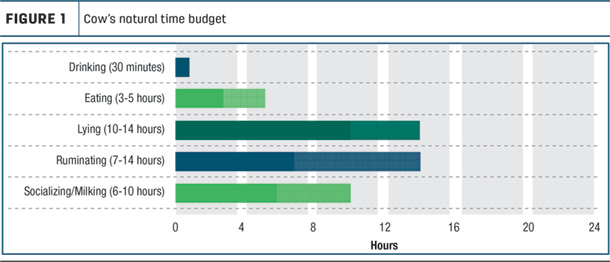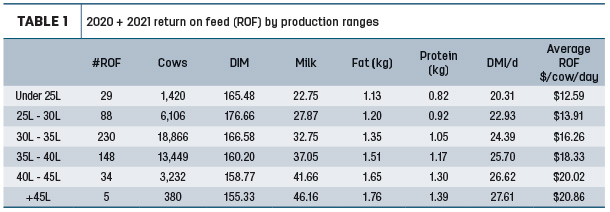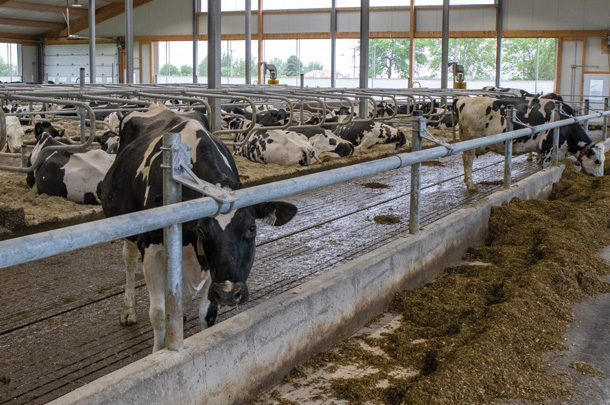The world has thrown a lot at everyone over the last two years. From jaw-dropping weather systems to record-setting commodity prices, the economic strain has been felt throughout the entire supply chain as tighter margins have become the norm.
As dairy producers, maintaining our financial position is paramount. Applying the CowSignals philosophy within our current facilities is one way to optimize profit margins economically.
This program is not new, but it is simple to understand and embodies the scientific platform to quantify the importance of herd behaviour dynamics on profit margins. Regardless of farm size, age or type of barn, every farm can apply various parts of the CowSignals diamond with noticeable economic returns.
Before we can determine our greatest area of opportunity, we need to keep in mind a cow’s natural time budget (Figure 1).

Dairy cows spend three to five hours per day eating, consuming between nine and 14 meals. Rumination accounts for an additional seven to 10 hours, which can take place during their 10 to 14 hours of lying or resting time. Let’s not leave out 30 minutes of drinking time, socializing and, of course, milking. Management decisions need to enhance the herd’s ability to perform all these activities consistently with minimal compromise. When time budget conflicts occur, herd behaviour changes to meet the need most negatively impacted.
For all herds, dry matter intake (DMI) has the greatest influence on milk production, animal well-being, herd health, body condition and reproductive performance. For the purpose of this article, we are going to focus on the importance space has on maximizing both rest and feed intake.
Space and feed
Decisions surrounding feedbunk space, stocking density and lying time dictate feed intake. Feedbunk linear space for the lactating group should be greater than 0.6 metre (24 inches), with a goal of 0.75 metre (30 inches) per cow. For transition cows, a minimum of 0.75 metre (30 inches) of space is required, with a goal of 1 metre (36 inches) for optimal results. As feed space drops, competitiveness increases, raising the dominance value of individual cows to maintain their required time budget. Due to increased competition, less aggressive animals will have their time budgets compromised to avoid the dominant behaviour of other cows in the group.
Feedbunk space is influenced by linear space of the eating area, as well as stocking density. For example, three-row barns at 100% stall stocking density will not have adequate feedbunk linear space for the entire group to eat at once. Two-row barns and perimeter-fed facilities can support the required linear space for eating. However, if the pen’s stocking density exceeds 100%, the same negative impacts begin to occur.
Nonetheless, having the correct feedbunk space and stocking density does not solve all our issues. Can the herd reach high-quality feed 24 hours of the day? Feed availability is just as important as feedbunk space. Though this topic has been discussed extensively over the years, if there is no feed available and/or accessible for the herd to consume, feedbunk space becomes a moot point. Ensuring high-quality feed is available across the feed fence and accessible by multiple feed push-ups throughout a 24-hour period is the cheapest way to positively impact feed intake behaviour. As a rule of thumb, for every additional 0.5 kilogram of DMI, there is an additional 1 litre of milk produced. With proper feed space and access to high-quality feed, feed intake behaviour will generate positive returns in the milk tank (Table 1).

Space and rest
A cow’s behavioural requirement for rest is her greatest priority within her normal time budget. If lying time is restricted, the cow will reduce the amount of time spent eating. This is a double-edged sword regarding animal well-being and herd productivity.
For every three-and-a-half minutes of rest lost, cows sacrifice one minute of eating time. At first glance, this does not seem like an issue. However, the margins are in the details. If a cow’s ability to rest is reduced by one hour per day, that eliminates 17 minutes of eating time. Most cows’ meals are between 30 to 45 minutes in length and consist of an average of 2.2 kilograms of DMI. With roughly half a meal bout removed, this could cause a reduction of approximately 1 kilogram of DMI and up to 2 kilograms of milk. Secondary to milk production, this loss of eating time will negatively impact body condition, reproductive performance and overall herd health.
If we consider the correlation between rest and milk production on its own, every hour over nine hours of rest will produce an average of 1 kilogram more milk per hour up to 14 hours. Monitoring herd behaviours for perching, standing in stalls, bunching, as well as how the animal lies in the stall, will tell you if rest is being compromised.
In terms of rest, the need for optional space is determined at both the stall and pen level. First looking at the stalls, if cows are perching or lying crooked, a few quick stall measurements will help determine what alterations can be made to the existing stalls to improve lying time. If cows are standing straight in the stalls but not lying down, investigate the softness of the lying material with the “knee-drop” test. Is there adequate bedding for the stall design used? Adding the correct amount of bedding and/or bedding more often can be a simple fix to encourage adequate lying time.
At the pen level, stocking density needs to be examined. For the main lactating herd, stocking density of 100% or less at both the stall and feed fence is recommended. For bedded-pack or compost barns, 100 square feet per cow of resting space is the standard.
As herds expand, there will be times when overcrowding is unavoidable. That said, it should be a short-term experience, as over time the negative impacts on herd dynamics will begin to take their toll.
One area of the farm that should never be overstocked is the transition area. Transition cows (including animals from far-off dry cows to fresh cows) require significantly more lying space. Not providing sufficient space during this critical time can lead to reduced milk production during the animal’s upcoming lactation period. For all transition animals, ideal stocking density is less than 80%. For every 10% increase in stocking density over 80% in the close-up dry group, future lactation milk production will suffer by roughly 0.75 kilogram per day. This effect is most noticeable in first-lactation heifers.
As you plan your day tomorrow, budget time to examine aspects surrounding space, rest and feed to see where some adjustments may put a few extra litres in the tank by tomorrow.









